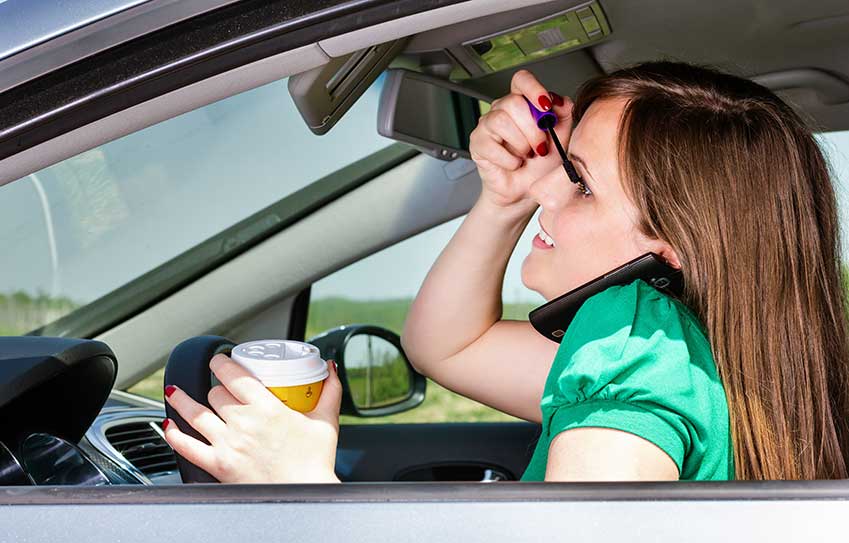Distracted driving is a public health issue that affects us all. According to the Centers for Disease Control and Prevention (CDC), the latest statistics show that each day about 9 Americans are killed and more than 1,000 are injured in crashes involving a distracted driver, including motorcycle crash injuries. It’s one of several reasons why the National Safety Council (NSC), government agencies, and NGO’s established April as “Distracted Driving Month” in an effort to call attention to this scourge that preys on motorists.
Distracted Driving Defined
According to the National Highway Traffic Safety Administration (NHTSA), there are 3 main types of driver distraction:
- Visual: driver taking their eyes off the road
- Manual: taking one’s hands off the wheel
- Cognitive: drivers letting their minds wander from the task of driving
Distracted driving can involve anything that takes your attention away from driving, leading to distracted driving accidents. Talking on a cell phone and using a vehicle’s navigation or infotainment system are common distractions. So are eating while driving, applying makeup, and interacting with vehicle passengers.
And while any of the above distractions endanger drivers and passengers, texting while driving is especially dangerous because it combines all 3 types of distraction. Sending or reading a text message takes your eyes off the road for at least five seconds. And for a car going 55 miles an hour, that’s enough time to travel the length of a football field.
Who are the Most Likely Distracted Driving Casualties?
Teen drivers. Those who are under age 20 cause the most fatal distracted driving crashes, according to the Distracted Driving: 2015 Report prepared by the National Center for Statistics and Analysis.
The CDC’s National Youth Risk Behavior Surveillance System (YRBSS) monitors health-risk activities among U.S. high school students, including texting while driving. Its most recent findings (in 2015) include the following:
- That year, nearly half (42%) of high school students who drove in the 30 days before the survey admitted that they sent at least one text or email while driving.
- Students who reported frequent texting while driving were:
- Less likely to wear a seatbelt
- More likely to drink and drive
- More likely to ride with a driver who had been drinking
What’s Being Done?
Designating months to draw attention to particular issues are all well and good. But how is distracted driving actually being combated?
Today, Texas and 46 other states, along with the District of Columbia, Puerto Rico, Guam, and the U.S. Virgin Islands, ban text messaging for all drivers. Also in Texas, all phone use is banned in school zones when lights are flashing.
Some states also use graduated driver licensing systems for teen drivers to reinforce the dangers of distracted driving and to help prevent it. However, the effectiveness of cell phone bans and texting laws is not yet clear and requires further study.
There is also a plethora of free software apps and vehicle computing system updates, designed to enhance road safety and support self-driving vehicles, which insulate and even prevent the receiving or sending of text messages by the driver when their vehicles are in motion.
If you or a family member have been hit by a driver who was texting, the accident and injury law office of Terry Bryant is available to evaluate your case free of charge; contact us anytime via telephone or through our website.
Attorney Terry Bryant
 Terry Bryant is Board Certified in personal injury trial law, which means his extensive knowledge of the law has been recognized by the Texas Board of Legal Specialization, setting him apart from many other injury attorneys. The 22 years he spent as a Municipal Judge, Spring Valley Village, TX also provides him keen insight into the Texas court system. That experience also helps shape his perspective on personal injury cases and how they might resolve. This unique insight benefits his clients. [ Attorney Bio ]
Terry Bryant is Board Certified in personal injury trial law, which means his extensive knowledge of the law has been recognized by the Texas Board of Legal Specialization, setting him apart from many other injury attorneys. The 22 years he spent as a Municipal Judge, Spring Valley Village, TX also provides him keen insight into the Texas court system. That experience also helps shape his perspective on personal injury cases and how they might resolve. This unique insight benefits his clients. [ Attorney Bio ]


 Terry Bryant is Board Certified in personal injury trial law, which means his extensive knowledge of the law has been recognized by the Texas Board of Legal Specialization, setting him apart from many other injury attorneys. The 22 years he spent as a Municipal Judge, Spring Valley Village, TX also provides him keen insight into the Texas court system. That experience also helps shape his perspective on personal injury cases and how they might resolve. This unique insight benefits his clients. [
Terry Bryant is Board Certified in personal injury trial law, which means his extensive knowledge of the law has been recognized by the Texas Board of Legal Specialization, setting him apart from many other injury attorneys. The 22 years he spent as a Municipal Judge, Spring Valley Village, TX also provides him keen insight into the Texas court system. That experience also helps shape his perspective on personal injury cases and how they might resolve. This unique insight benefits his clients. [ 

